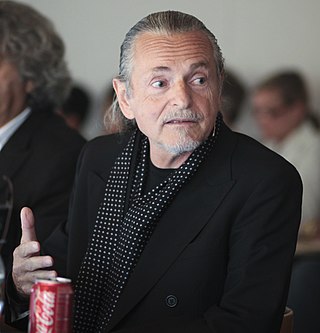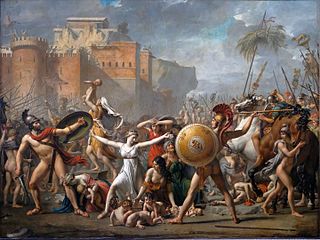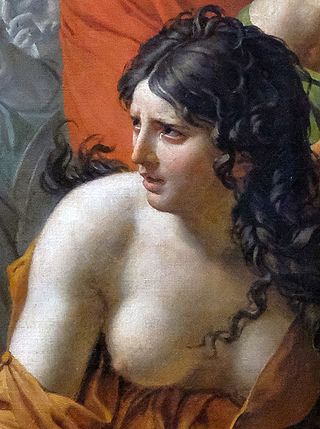
Jacques-Louis David was a French painter in the Neoclassical style, considered to be the preeminent painter of the era. In the 1780s, his cerebral brand of history painting marked a change in taste away from Rococo frivolity toward classical austerity and severity and heightened feeling, harmonizing with the moral climate of the final years of the Ancien Régime.

Jeanne Françoise Julie Adélaïde Récamier, known as Juliette, was a French socialite whose salon drew people from the leading literary and political circles of early 19th-century Paris. An icon of neoclassicism, Récamier cultivated a public persona as a great beauty, and her fame quickly spread across Europe. She befriended many intellectuals, sat for the finest artists of the age, and spurned an offer of marriage from Prince Augustus of Prussia.

Krzysztof Wodiczko is a Polish artist known for his large-scale slide and video projections on architectural facades and monuments. He has realized more than 80 such public projections in Australia, Austria, Canada, England, Germany, Holland, Ireland, Israel, Italy, Japan, Mexico, Poland, Spain, Switzerland, and the United States.
Rosalind Epstein Krauss is an American art critic, art theorist and a professor at Columbia University in New York City. Krauss is known for her scholarship in 20th-century painting, sculpture and photography. As a critic and theorist she has published steadily since 1965 in Artforum,Art International and Art in America. She was associate editor of Artforum from 1971 to 1974 and has been editor of October, a journal of contemporary arts criticism and theory that she co-founded in 1976.
Eva Hoffman is an internationally acclaimed, award-winning writer and academic.
Sarah Sze is an American artist and professor of visual arts at Columbia University. She has exhibited internationally and her works are in the collections of several major museums. Sze's work explores the role of technology and information in contemporary life utilizing everyday materials. Drawing from Modernist traditions, Sze's work often represents objects caught in suspension.
Pierre Max Rosenberg is a French art historian, curator, and professor. Rosenberg is the honorary president a director of the Musée du Louvre in Paris, and since 1995, he has held the 23rd seat of the Académie Française. He was Slade Professor of Fine Art at the University of Cambridge in 1987.

The Death of Marat is a 1793 painting by Jacques-Louis David depicting the artist's friend and murdered French revolutionary leader, Jean-Paul Marat. One of the most famous images from the era of the French Revolution, it was painted when David was the leading French Neoclassical painter, a Montagnard, and a member of the revolutionary Committee of General Security. Created in the months after Marat's death, the painting shows Marat lying dead in his bath after his murder by Charlotte Corday on 13 July 1793. Art historian T. J. Clark called David's painting the first modernist work for "the way it took the stuff of politics as its material, and did not transmute it".

Hannah Wilke was an American painter, sculptor, photographer, video artist and performance artist. Wilke's work is known for exploring issues of feminism, sexuality and femininity.

André Antoine Bernard called Bernard de Saintes, was a French lawyer and revolutionary, one of the Jacobins responsible for the Reign of Terror in the French Revolution.

The Death of Socrates is an oil on canvas painted by French painter Jacques-Louis David in 1787. The painting was part of the neoclassical style, popular in the 1780s, that depicted subjects from the Classical age, in this case the story of the execution of Socrates as told by Plato in his Phaedo. In this story, Socrates has been convicted of corrupting the youth of Athens and introducing strange gods, and has been sentenced to die by drinking poison hemlock. Socrates uses his death as a final lesson for his pupils rather than fleeing when the opportunity arises, and faces it calmly. The Phaedo depicts the death of Socrates and is also Plato's fourth and last dialogue to detail the philosopher's final days, which is also detailed in Euthyphro, Apology, and Crito.

The Intervention of the Sabine Women is a 1799 painting by the French painter Jacques-Louis David, showing a legendary episode following the abduction of the Sabine women by the founding generation of Rome.

Portrait of Madame Récamier is an 1800 portrait of the Parisian socialite Juliette Récamier by Jacques-Louis David showing her in the height of Neoclassical fashion, reclining on a Directoire style sofa in a simple Empire line dress with almost bare arms, and short hair "à la Titus." The work is unfinished.

Down There is a 78-minute 2006 Belgian-French English- and French-language independent documentary art film directed by Chantal Akerman.

Annette Lemieux is an American artist who emerged in the early 1980s along with the “picture theory” artists. Lemieux brought to the studio a discipline equally based on introspection, and the manifestations of an ideological minimalism. Process is a key component in the execution of her works over the past three decades, creating the lure to the confrontation of issues of social and historical urgency. Lemieux has been the recipient of awards from the National Endowment of the Arts and the Keiser Wilhelm Museum, Germany and an honorary Doctorate in Fine Arts from Monserrat College of Art. Presently, in addition to her studio and exhibition schedule, she is a senior lecturer at Harvard University in the area of visual and environmental studies.

Henriette de Verninac (1780–1827) was the daughter of Charles-François Delacroix, minister of Foreign Affairs under the Directory, and wife of the diplomat Raymond de Verninac Saint-Maur. She is known as the subject of a portrait by Jacques-Louis David.

Psyche Abandoned is a c. 1795 painting by Jacques-Louis David, now in a private collection. It shows Psyche as a crouching female nude in profile against a blue sky with a hill in the background. She stares at the viewer with an expression of loss, pain, and betrayal. Thought to have been painted during David's imprisonment during the French Revolution, it dates from either 1794 or 1795. Vertical in format, it diverges from the academic conventions for representing the female nude.

Birgit Jürgenssen (1949–2003) was an Austrian photographer, painter, graphic artist, curator and teacher who specialized in feminine body art with self-portraits and photo series, which have revealed a sequence of events related to the daily social life of a woman in its various forms including an atmosphere of shocking fear and common prejudices. She was acclaimed as one of the "outstanding international representatives of the feminist avant-garde". She lived in Vienna. Apart from holding solo exhibitions of her photographic and other art works, she also taught at the University of Applied Arts Vienna and the Academy of Fine Arts Vienna.
Hillary Leone is an American conceptual artist who works across installation, sculpture, video, photography, digital, and writing mediums. Her work has focused on the intersection of art, science, and technology.

Adélaïde Victoire Noyel, Comtesse de Bellegarde, known as Adèle de Bellegarde, was a Savoyard aristocrat. During the French Revolution, she became a popular salon hostess in Paris, and modelled for Jacques-Louis David's 1799 painting The Intervention of the Sabine Women.














